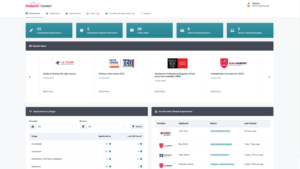Staying one step ahead of education innovation

Some industries achieve change. And some have change thrust upon them. Across every sector, a sense of urgency has fast-forwarded digital adoption in a way we’ve never seen before. And higher education is no exception.
Following COVID-19’s lockdown restrictions, ideas and implementations that might once have been deemed ‘too hard’ or ‘a year in the making’ are now being tested in days or weeks.
Having seen the sector through change over the past three decades, we know it’s also important to reflect. What’s working, what could be improved, and what can we learn from the experience of others – and from the recent past?
The quick takeaway is – don’t get sucked in by the technology just because it’s new and shiny. The 4Ps of marketing, expanded to the 7Ps for services, should still drive strategy. There are just an increasing number of tactical options that can be used to achieve your strategy thanks to technology.
Challenging assumptions since 1996
Believe it or not, this is the third major digital disruption of international education I’ve worked through. Over the years, seeing the student experience from its very first touchpoint has made me realise how important the complete customer journey of marketing, recruitment and admissions processes are to the overall higher ed experience.
When students make the right decision about where and what to study, they have a better experience – and better learning outcomes. When agents are supported to guide those decisions with the right information and tools, they build positive relationships with their institution partners.
Make no mistake, recruiting the best students is very much a relationship marketing strategy. It’s not one you can casually outsource.
So how has this process been disrupted over the past three decades? From print only, to CD ROM to online – and now to cloud-based efficiency with algorithmic intelligence.
First, there were CD-ROMs. At a time when student information was limited to a heavy prospectus, suddenly postage-stamp-sized video pitches were possible on a disk as part of a ‘virtual’ tour. I remember demonstrating one for an Australian college to a UK Vice Chancellor in 1996. He wasn’t sure this video thing would catch on.
While the internet was still in its infancy, StudyLink launched a web directory in 1998 to make it easier for institutions to transition from print to web. Our online counselling tool helped universities convert enquiries into applications, effectively enrolling students as one of the first ‘online agents’.
So what’s next?
We have always operated by testing, learning and improving. Over the past few months, I’ve had many (virtual) conversations, and some time to reflect on where I see the most exciting future opportunities.
Despite technology offering an impressive range of options (and a more impressive range of promises) it is important to remember a marketing strategy still needs to be grounded in the 4Ps and 7Ps. Each new option needs to be assessed and measured as part of a tactical plan to achieve your marketing strategy.
- Remote student engagement has never been more important. Connecting prospective students with current students can help them have more certainty about their experience, so those peer connection platforms matter. You might also want to consider ways your team can engage instantly with applicants or agents via LivePerson or other chat tools. What’s also important is how this fits into your engagement and conversion plan. Brand, tone of voice and messaging all need to be consistent.
- We’re now used to working and communicating online. WhatsApp, Slack, Teams, Zoom, Google Chat – work out what works for your teams and your agents. This is a great way to strengthen relationships – but beware the rising risk of Zoom fatigue. (You might like an article my colleague wrote recently about the best ways to engage agents while meeting face to face isn’t possible.)
- Virtual Fairs have the potential to be so much more. Out of necessity, we’re seeing a lot of PowerPoints on Zoom replace traditional open days and agent fairs – but these do very little to inspire excitement. More dynamic virtual event platforms could expand your reach beyond local students and agents. Be careful how you approach this. Replicating what we do in the real world doesn’t always work online. The value of a fair is the casual connections you make and this is hard online. Think about why you want to run an online fair and whether there are better and more personal alternatives. For example, you might consider collaborating with your agent partners to deliver F2F in-country recruitment events.
- Online conversion is the real deal. One of the biggest friction points for many students is the application process itself. Providers spend time and energy nurturing leads, only to lose them in a bewildering maze of forms and conflicting information. Something it’s important to watch is separating enquiries from genuine applications. Admissions teams will thank you if your system only delivers complete, qualified applications: it shouldn’t take thousands of applications to achieve one enrolled student. Use the technology as part of an online conversion process rather than driving people to submit an application as an early step in the process.
- Your agents can be your greatest resource at this time – in-country or online orientation can make the right first impression. If students can’t be on campus for orientation, bring orientation to them. Using agent offices as a physical connection (or as an online event), they can meet their future peers before they arrive. Train agents to run briefings on what to expect, and how students can make the most of their experience. You could also consider involving your agents in supporting remote learning with in-country study groups.
- Use data to make smarter decisions. We’ve never had so much information. But is it accurate, and does it provide the insights you need? Measure, track and adjust. Run benchmarking and pinpoint issues like specific agent conversion rates.
Each of the tactical approaches listed above don’t need to be approached in isolation. We’re in the final stages of development for a new release of our Capture solution. Capture helps education providers strengthen agent relationships and simplify the application process for agents, direct applicants and admissions teams. Importantly, it focuses on the capture and transaction of quality information to ensure Admissions teams are investing time on complete and genuine applications only.
Because even though things could go back to normal in a post-pandemic world, they shouldn’t. Normal wasn’t working. This is our chance to think about things differently, and make change for the better.
Learn how StudyLink Connect can convert more quality applications to your institution, submit an enquiry to talk to our Sales team.



